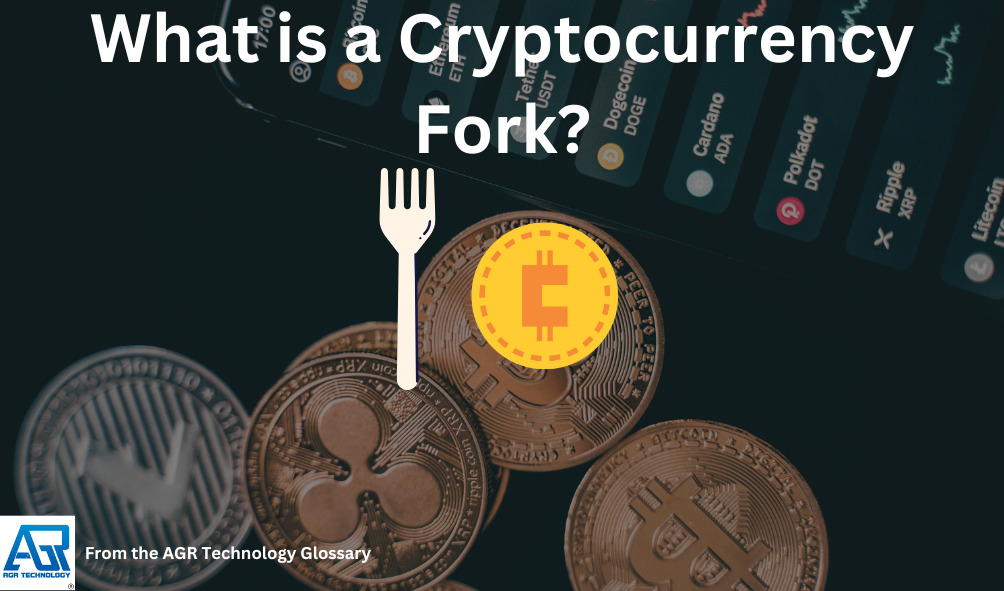What is a cryptocurrency fork and how does it work?

A cryptocurrency fork occurs when there is a divergence in the blockchain, resulting in two separate versions of the cryptocurrency. This can happen due to updates or changes in the software. Forks can be classified as hard forks or soft forks, depending on their impact on the blockchain’s compatibility.
In 2008, an unknown person or group of people using the pseudonym “Satoshi Nakamoto” published a white paper explaining the idea of a decentralized digital currency named Bitcoin. Blockchain forks have received a lot of attention in the context of the bitcoin scalability issue.
The evolution of cryptocurrency splits has resulted in a wide range of digital assets, such as Litecoin, each resulting from a unique fork scenario. These alternative cryptocurrencies frequently develop as responses to specific difficulties or as features that differ from their predecessors. Investors and aficionados can purchase these digital assets on cryptocurrency exchanges in countries such as Australia, Bitcoin trading platforms for Hong Kong users, Dubai/UAE, Norway, region of Taiwan, Singapore area and New Zealand to mention a few. End consumers can participate in the decentralized financial environment by buying and selling various sorts of assets on local crypto exchanges.
What are Cryptocurrency Forks
Cryptocurrency is a constantly evolving space, with new developments and changes coming up every now and then. One such development that has been making the rounds lately is cryptocurrency forks. If you are a cryptocurrency enthusiast, chances are you might have heard about them, but do you know what they are and how they work? In this glossary page, we will dive deep into the world of cryptocurrency forks. We will cover everything from their definition and purpose to exploring the different types of forks. We will also discuss their impacts and consequences on the original cryptocurrency, potential risks and benefits to cryptocurrency users, and notable examples of major forks in the past. Additionally, we will look at how these forks influence market behavior and whether all forks are equally significant or not.
Understanding Cryptocurrency Forks

Forks in cryptocurrencies occur when there are disagreements within the blockchain community, leading to the creation of a new version with different rules. This can result in the formation of new cryptocurrencies and have significant implications for the crypto world. When dealing with forks, investors need to conduct due diligence as they can result in permanent splits that lead to different chains. There are two types of forks: hard and soft forks, each having a different impact on the cryptocurrency ecosystem.
Hard forks involve a complete divergence from the existing blockchain, resulting in two separate and independent chains. This type of fork can be contentious and often leads to significant changes in the cryptocurrency’s underlying code and its subsequent value. Soft forks, on the other hand, involve minor modifications to the existing blockchain, which do not result in a permanent split. Instead, all nodes on the network agree to adopt these changes, ensuring compatibility with previous versions.
Investors should consider potential risks associated with hard forks like chain splits which can create confusion and lead to market volatility. It is important for investors to understand the differences between hard and soft forks while conducting their research before making investment decisions. Understanding these differences can help them make informed decisions about which cryptocurrencies to invest in and how best to manage their portfolios during times of change or uncertainty.
Definition and Purpose of Cryptocurrency Forks
Cryptocurrency forks signify a radical change in the blockchain protocol, stemming from disagreements within the community and leading to new rules. These forks can create a new set of rules for the cryptocurrency network, potentially resulting in the formation of a new coin, asset, or chain. The primary objective of cryptocurrency forks is to upgrade the functionalities of the blockchain network, enhancing its capabilities and performance in the ever-evolving landscape of digital assets.
The Role of Cryptocurrency Forks in the Blockchain Ecosystem

Cryptocurrency forks impact the main chain, generating newer versions of the cryptocurrency protocol. They can lead to the implementation of a new protocol, enhancing blockchain features and resulting in larger blocks that affect transaction fees and network scalability. Forks are often a result of disagreements within the blockchain community, sometimes leading to the creation of new cryptocurrencies with different functionalities. This evolution of the blockchain ecosystem through forks reflects the ever-changing landscape of digital assets.
Hard forks result in a permanent split from the original blockchain, creating a new coin, while soft forks involve a network upgrade with new rules, maintaining the old chain. Cryptocurrency forks can lead to a new version of the protocol and codebase, as well as the creation of different chains with unique features and rules. The various types of cryptocurrency forks include hard forks, soft forks, and blockchain forks.
Hard Forks
Hard forks result in the creation of a newer version of the blockchain with updated rules, often due to disagreements. This can lead to the generation of a new cryptocurrency asset, impacting the existing blockchain. The forked code from hard forks causes a permanent split, resulting in a new chain with different features and functionalities. Overall, hard forks play a crucial role in shaping the evolution and development of the cryptocurrency network.
Soft Forks
Soft forks involve a network upgrade with new rules, maintaining the original chain. They result in a backward compatible upgrade, with the old version still valid, aiming to introduce new rules without creating a permanent split in the network. Users can continue using the old software after a soft fork. Additionally, soft forks impact the transaction validation process by introducing new rules to the network, demonstrating their influence on the cryptocurrency ecosystem.
Impacts and Consequences of Cryptocurrency Forks

Forks in the cryptocurrency space often lead to disagreements within the community, resulting in a split and impacting the original cryptocurrency. This creates new versions with different rules, potentially leading to the emergence of new coins, assets, or chains, affecting the crypto ecosystem. These forks may cause a divide within the blockchain community due to differing perspectives, ultimately impacting the original blockchain and cryptocurrency network with a new set of rules.
Effects on the Original Cryptocurrency
Forks have the potential to split the original blockchain, giving rise to a new chain with updated rules. As a result, the original cryptocurrency may undergo rule changes, leading to the creation of a new version. The introduction of new rules through forks can impact the original cryptocurrency network. This may result in the coexistence of the original cryptocurrency with a newer version, thereby affecting the network.
Potential Risks and Benefits to Cryptocurrency Users
Cryptocurrency users face potential risks such as network instability and market uncertainty due to forks. However, forks also offer benefits like new features and investment opportunities through the creation of new cryptocurrencies. It’s crucial for users to weigh the potential risks and rewards associated with forks, considering the impact on the cryptocurrency market and their investments.
Notable Examples of Cryptocurrency Forks
The creation of Bitcoin Cash stemmed from a hard fork in the Bitcoin network. Ethereum community members encountered the contentious DAO fork. Bitcoin’s hard fork led to the emergence of Bitcoin Gold, while Bitcoin SV resulted from another network fork. Additionally, cryptocurrency proponents observed a hard fork resulting in the creation of a new cryptocurrency, showcasing the diverse types of forks and their impact on the blockchain ecosystem.
The Emergence of Bitcoin Cash and Its Impact on Bitcoin
The split within the Bitcoin community led to the emergence of Bitcoin Cash, resulting from a hard fork and the creation of a new cryptocurrency. This hard fork introduced different chains and a permanent split, with a larger block size limit and new features. The emergence of Bitcoin Cash significantly impacted the original blockchain, altering the dynamics of the cryptocurrency market.
The DAO Hack and Ethereum Classic
The occurrence of The DAO hack prompted a hard fork, giving rise to Ethereum Classic. This event brought about a significant transformation in the Ethereum community. Ethereum Classic stands for the original version of the protocol, upholding the old chain. This division established a fresh set of rules and functionalities within the cryptocurrency world. The Ethereum community encountered a substantial discord over the hard fork, resulting in the split.
The Process Behind the Creation of Cryptocurrency Forks

Cryptocurrency forks emerge from disagreements within the blockchain community, often sparked by new rules or modified ones, leading to the adoption of a new protocol or blockchain upgrade. This process results in the creation of new cryptocurrencies with different chains. Initiating a fork involves implementing a new version of the protocol, influencing market behavior and creating investment opportunities. Miners, developers, and the cryptocurrency community play crucial roles in accepting or rejecting forks, impacting the market significantly.
The Role of Miners and Developers in Initiating Forks
Cryptocurrency forks are initiated through the actions of miners and developers, who hold significant influence over the blockchain. Their decisions can lead to the creation of a new chain with a forked code, often stemming from disagreements within the cryptocurrency network. The mining community’s support for a fork can notably impact the blockchain, while developers’ contributions to the forked software can determine the success of the new asset. This demonstrates the pivotal role played by miners and developers in the initiation of cryptocurrency forks.
The Role of the Cryptocurrency Community in Accepting or Rejecting Forks
The consensus of the blockchain community is pivotal in determining the fate of proposed forks. Community acceptance can lead to the creation of a new coin and chain, while disagreements may result in a split, leading to different chains. The response from investors and members significantly influences the future of the cryptocurrency network. Forks, whether hard or soft, hinge on the support of the community, shaping the old rules of engagement and giving rise to new blocks, further defining the open-source nature of the ecosystem.
How Cryptocurrency Forks Influence Market Behavior
Cryptocurrency forks have a substantial impact on market behavior, triggering responses that influence investor sentiment. Major forks result in price volatility, creating trading opportunities and generating interest in the new coin and chain. Investor reactions reflect the community’s confidence in the cryptocurrency’s future, shaping market behavior for related cryptocurrencies and tokens. The influence of cryptocurrency forks on market dynamics demonstrates the interconnected nature of the digital asset landscape.
Market Responses to Major Cryptocurrency Forks
Market responses to major cryptocurrency forks often result in increased trading volumes and price fluctuations. This can create uncertainty, affecting the value of the original cryptocurrency and prompting investors to closely monitor market responses for trading opportunities. The launch of a new coin through a fork can significantly impact the market dynamics of the original cryptocurrency, leading to speculation, arbitrage, and the redistribution of investment portfolios. The market’s reaction to forks reflects investors’ confidence in the future of the cryptocurrency network.
How Forks Can Create Investment Opportunities
Investors seeking diversification can capitalize on forked coins and chains, creating new investment assets in the crypto space. The introduction of a new coin through a fork can lead to airdrops, benefiting existing token holders and providing investment options. Additionally, market movements triggered by major cryptocurrency forks present trading opportunities for risk-tolerant investors, reflecting the community’s confidence in the future of the cryptocurrency. This dynamic market behavior showcases how forks can create investment opportunities and contribute to portfolio expansion.
Are all Cryptocurrency Forks Equally Significant?
Not all cryptocurrency forks carry the same weight in the digital currency landscape. The significance of a fork depends on factors like the community’s response, market behavior, and the creation of new coins with unique features. Hard forks, for example, can result in permanent splits and the emergence of new chains. Investors assess the potential impact of forks on the cryptocurrency market.
Frequently Asked Questions
Are there any risks or downsides to participating in a cryptocurrency fork?
Participating in a cryptocurrency fork comes with risks. It involves splitting from the original blockchain and there is a possibility of losing your original coins or experiencing technical issues. Forks may also lead to confusion and fragmentation in the cryptocurrency community. Research and understanding the risks are important before participating in a fork.
What are the different types of cryptocurrency forks?
There are two main types of cryptocurrency forks: hard forks and soft forks. Hard forks create a new blockchain separate from the original, while soft forks make changes to the existing blockchain. Contentious hard forks occur when there is disagreement among the community about proposed changes. Notable examples include Bitcoin Cash and Ethereum Classic.
How do cryptocurrency forks affect the value and usability of the original currency?
Cryptocurrency forks have a significant impact on the original currency’s value and usability. When a fork occurs, it can result in the creation of a new currency with different rules and features. This can lead to users switching to the new forked currency, affecting the value of the original. Additionally, forks can create confusion and make it more challenging to use the original currency. It’s crucial for cryptocurrency users to stay informed about potential forks and their implications.
What are the differences between a hard fork and a soft fork?
A hard fork and a soft fork differ in their impact on the blockchain. While a hard fork creates a permanent split and requires all nodes to upgrade, a soft fork does not result in a split and only needs a majority to upgrade. Hard forks often lead to new cryptocurrencies, making them more controversial than soft forks.
Conclusion
In conclusion, cryptocurrency forks play a significant role in the blockchain ecosystem. They can result in the creation of new cryptocurrencies or the modification of existing ones. Whether it’s a hard fork or a soft fork, these events have impacts and consequences on the original cryptocurrency and its users. Notable examples, such as Bitcoin Cash and Ethereum Classic, have demonstrated the potential risks and benefits associated with forks. The process behind creating a cryptocurrency fork involves the collaboration of miners, developers, and the cryptocurrency community. Furthermore, forks can influence market behavior and create investment opportunities. So, next time you come across news about a cryptocurrency fork, take the time to understand its significance and share your insights on social media.
Related pages on our website:
Digital Wallets / Smart Wallets
Simple guide to buy Bitcoin in Australia
Fintech (Financial Technology)
What is a Neobank and how does it work?
Interactive tool that lists current prices of Cryptocurrencies
Blockchain Explorer Definition
Cryptocurrency Market Analysis Definition
List of platforms to help you accept Cryptocurrency payments on your website
What are Initial Exchange Offerings (IEOs)
Some of the best small business loan providers in Australia
Top CFD Broker Apps for the UAE
Net worth calculator – online tool
Mortgage affordability calculator – online tool
Buyers guide to choosing the best CFD brokers & apps in Australia
Leading Cryptocurrency exchanges for Indian users
Top-rated Crypto exchanges for South Africa
Some of the best Cryptocurrency exchanges & apps for Saudi Arabia
Some of the best small business loan providers for Perth
Top Alternatives to Swyftx for Australian Crypto users
CMC Markets Alternatives for Australia
Coinspot alternatives platforms Australian Crypto users
Cryptocurrency wallet data recovery services by AGR Technology
Web3 Marketing Services By AGR Technology
Some of the best loan providers for Melbourne businesses
Top Sydney business loan brokers
The best day trading applications/platforms for Australians
Top Forex trading brokers for Canadian users
Top Etoro alternatives for Australian forex traders
What to look for when choosing a neobank app
Some of the leading forex trading platforms for New Zealand users
Top-rated Alternatives to Etoro for Australian CFD traders
Some of the best Cryptocurrency exchanges/apps for Canadians
Web3 Software Development Services
NFT Digital Marketing Services
(Guide) How to buy Cryptocurrency in Australia
Best places to earn interest on your Cryptocurrency assets
How to buy Bitcoin online or other Cryptos
What is Web3 Gaming?
Best stock market trading platforms Australia to buy shares
How to pay overseas contractors from Australia online
How to buy Etherium (Eth) in Australia
Source(s) cited:
28 Sept. 2018, hibusiness.ca/wp-content/uploads/2018/09/According-to-Recent-Studies-Hard-Forks-Carry-Stability-Threat-for-Cryptocurrency-%E2%80%94-Coinzdaily-770×415-800×416.png. Accessed 7 Dec. 2023.
[Online]. Available at: https://i.pinimg.com/originals/ff/81/e5/ff81e52f0c3650e12f40d255352d0539.png (Accessed: 7 December 2023).
Fork (blockchain). Wikipedia. https://en.wikipedia.org/wiki/Fork_(blockchain). Published January 5, 2018. Accessed December 7, 2023.
Etoro [Online]. Available at: https://www.etoro.com/news-and-analysis/etoro-updates/a-brief-history-of-litecoins-developments-and-forks/ (Accessed: 7 December 2023).
Bio, Full. “A History of Bitcoin Hard Forks.” June 2, 2023. Accessed December 7, 2023. https://www.investopedia.com/tech/history-bitcoin-hard-forks/.
![logo-new-23[1] logo-new-23[1]](https://agrtech.com.au/wp-content/uploads/elementor/thumbs/logo-new-231-qad2sqbr9f0wlvza81xod18hkirbk9apc0elfhpco4.png)